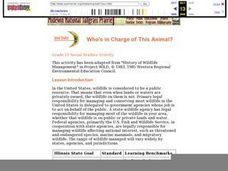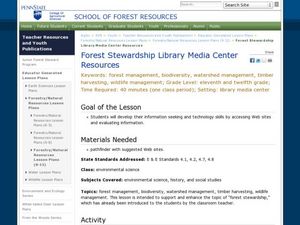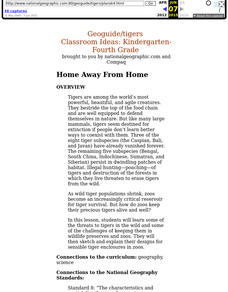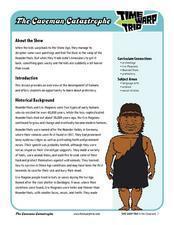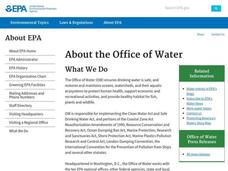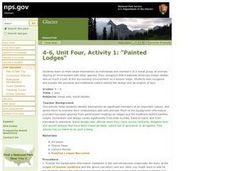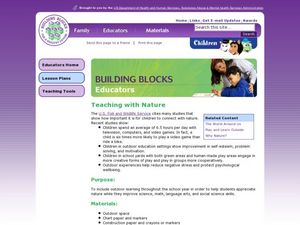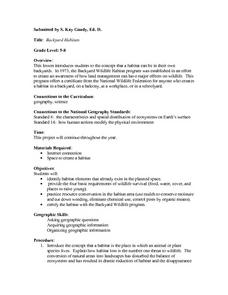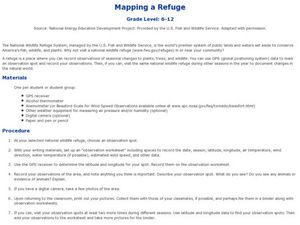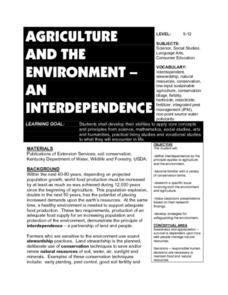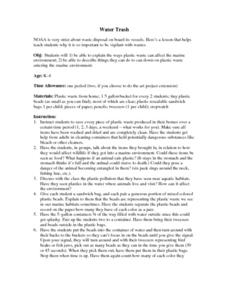Curated OER
Who's in Charge of This Animal?
Eleventh graders study wildlife management and identify the appropriate government agencies that are in charge. They examine different wildlife management techniques. They write a letter showing interest in the activities of one of the...
Curated OER
The Superheroes of Public Land Management
Students study public land management agencies and their missions. They research a management agency, design a superhero to represent the agency and describe the skills and training needed to manage public lands. They include the...
Curated OER
Forest Stewardship Library Media Center Resources
Young scholars develop their technology skills by accessing web sites and evaluating information. In this research instructional activity students research forestry topics and write a paragraph on the accessed websites.
Curated OER
The Social and Economic Impact of Wildlife and Natural Resource Management
Students develop an understanding of environmental laws and regulations. In this research lesson, students utilize information that involves controversial issues of wildlife and society.
Curated OER
Home Away From Home
Students discover some of the threats to tigers in the wild and some of the challenges of keeping them in wildlife preserves and zoos. They then sketch and explain their designs for sensible tiger enclosures in zoos.
Curated OER
Molehill or Mountain
Learners explore the concept of waste management. In this environmental stewardship lesson, students consider the trash generated by people per day and discuss what steps they can personally take to reduce waste.
Time Warp Trio
The Caveman Catastrophe
Young archaeologists study the development of human history, and work in groups to create a timeline that traces the development of humans. Additionally, the groups utilize a very clever graphic organizer embedded in the plan in order to...
Curated OER
Turning the Tide on Trash: Marine Debris Curriculum
Six different lessons comprise this unit on marine debris. Science, language arts, social studies, and art projects make this an ideal interdisciplinary unit. The result will be well-informed future citizens who can help make a...
Curated OER
Painted Lodges
Students explore lodge construction as a representation of culture. In this cultural diversity and Native American history lesson, students listen to a narrative explaining the origin of Native American painted lodges. Students design...
Curated OER
Teaching with Nature
Students participate in a nature walk to learn about their natural environments. In this nature study activity, students brainstorm a list of things to look for on their nature walk. Students go on the nature walk and locate objects they...
Curated OER
Backyard Habitats
Students identify habitat elements. They create a habitat in a backyard, on a balcony, at a workplace, or in a schoolyard and provide the four basic requirements of wildlife survival (food, water, cover, and places to raise young). They...
Curated OER
To Fish or Not to Fish?
Young scholars demonstrate the decision-making process for marine reserves designations. For this role-playing lesson students analyze maps and data relating to a proposed reserve. They formulate the best decisions based on overall issues.
Curated OER
Google Earth on the Range
Eighth graders use Google Earth to study the landscape of Utah. For this Utah landscape lesson, 8th graders view landscape photos and work in partners to analyze the pictures. Students write a paragraph that describes the landscape and...
Curated OER
Mapping a Refuge
Students record observations gathered while at a national wildlife refuge. In this instructional activity on wildlife refuges, students choose an observation spot and record seasonal changes throughout the year.
Curated OER
Life of a Logger
Young scholars are introduced to the work and lives of 19th century lumberjacks through a living history slide show presentation. They compare and contrast life 150 years ago with the present. Students describe the history of logging in...
Curated OER
Public lands: Preserve or develop?
Learners compare and contrast the characteristics of various public lands in Canada, including national forests, wilderness areas, national and provincial parks, wildlife sanctuaries, recreation areas and national historic sites. They...
Curated OER
The Importance and Future Of Canadian Resources
Ninth graders examine Canadian natural resources. In this geography skills lesson, 9th graders research answers to questions regarding Canada's water, energy, forests, and wildlife. Students use their findings to create posters that...
Curated OER
Bay B C's
In this unit of lessons, students examine the Chesapeake Bay area. Students learn what lives here and how humans are affecting the area.
Curated OER
Cathlapolte.... Catching Time's Secrets
Third graders investigate nature by studying a Chinook village from the past. In this sustainable living instructional activity, 3rd graders examine the architecture, environment and activities of the Chinook people. Students...
Curated OER
The Wildland/Urban Interface Dilemma
Learners examine all sides of the issues surrounding wildland fire. Groups assume the roles of different people who must decide what to do about a fictitious wildfire. They have a discussion to analyze the issue. A good, real life lesson!
Curated OER
Who Works in This Forest?
Students examine the variety of jobs that are related to working in the forest. Information on the different jobs is provided in this lesson plan for the teacher to share with the students. The students create a collage using magazines...
Curated OER
Agriculture and the Environment
Young scholars investigate the interdependence of agriculture and the environment. They research areas of interdependence and provide examples of situations where farmers are practicing conservation in the local area. Their findings are...
Curated OER
Paper or Plastic: Exploring Renewable Resources.
Students discuss, develop, invent, and implement a plan for making informed personal economic decisions about renewable resources.
Curated OER
Water Trash
Students examine how plastic waste affects the marine environment. They describe techniques that reduce plastic waste in this environment after examining plastic waste that accumulates in their own homes.
